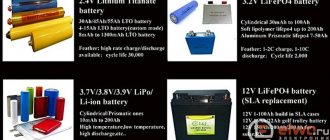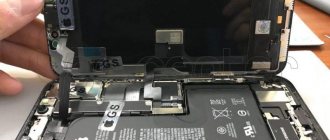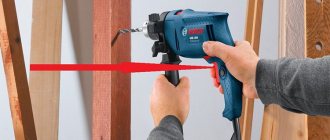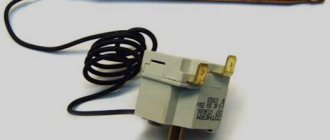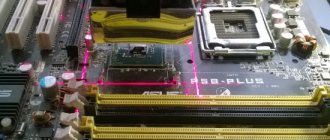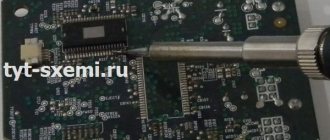Soldering stations are mainly used in professional environments, although anyone can purchase them. This is quite powerful equipment that is suitable for many different operations, including the restoration of complex equipment. The station can include not only a standard soldering iron, but also a hot air dryer.
In addition, any station has a so-called control module and galvanic isolation from the network. The presence of galvanic isolation minimizes possible negative consequences from soldering (black smoke or electric shock).
The soldering station is also distinguished from ordinary soldering irons by its temperature stability during operation, which is critical when soldering printed circuit boards.
Contact and non-contact
Now soldering stations are presented in a significant variety.
They can be divided into groups according to several parameters. For example, they are contact and non-contact. A contact station is an ordinary soldering iron that has direct contact with the surface when soldering, equipped with an electronic control and temperature control unit. That is, this is the most standard variety, which is suitable even for beginners.
Contact stations, in turn, can be divided into two subtypes depending on the solder used. Some models use only lead-containing solders, while others also use lead-free solders.
In the latest modifications, the heating element has a power of up to 160 watts. In this case, increased power is absolutely necessary, because the melting temperature of lead-free solders is quite high.
As for contactless stations, they can be used, among other things, for operations with microcircuits. A non-contact soldering unit can be hot-air, infrared or combined, and each of these three types has its own principle of operation.
Device classification
In stores you can find a wide selection of such devices. Basically, a soldering station is an electronic unit for setting the temperature and a soldering iron.
Despite the huge range, the following types of soldering stations can be distinguished depending on the solder used: the first are designed to work with tin-lead solders, and the second - without lead.
The second type is distinguished by the presence of a separate heating element. Its power can reach 160 W. This is due to the fact that the melting point of lead-free solders is quite high. In this regard, more power is needed.
At the same time, such devices have the ability to adjust the temperature, which makes it possible to work with low-melting lead alloys.
Drawing of a soldering iron and hair dryer in a soldering station.
Depending on the principle of operation of the blocks, stations are divided into:
- analog and digital;
- according to the heating method - induction and non-contact.
The latter, in turn, can be infrared, thermal air or combined. When choosing this device, you need to decide what needs to be soldered. For example, infrared ones are perfect for microcircuits.
A soldering station with a hair dryer does an excellent job of dismantling radio components with a large number of leads. Conventional soldering irons will not cope with this task.
Hot air soldering stations
To work with circuits with a large number of pins, contactless stations are used. Infrared is one of their varieties. Heating in this device occurs due to a special ceramic element.
Such equipment has a number of advantages:
- the ability to work with complex-profile microcircuits;
- radio components are not blown away by air flow;
- uniform heating of the product.
The main disadvantage of this device is its high cost. In this regard, it can be safely classified as a professional station. Beginner radio amateurs very rarely use such equipment.
Soldering stations with a hair dryer are used mainly for dismantling microcircuits, as noted above. In the absence of this equipment, specialists can use an industrial hair dryer or burner. However, such devices do not allow high-quality work to be done.
A sufficiently strong air flow can blow away radio components, and an incorrectly chosen temperature regime can completely damage them.
Professional devices allow you to adjust operating modes, which greatly simplifies the dismantling process.
The combined version combines a hot air gun, a soldering iron for the station and other types of equipment. Using such devices is quite simple. For example, to solder wires, it is enough to set the temperature of the electric soldering iron and tin them using flux and tin.
Contact and non-contact soldering stations
All modern soldering stations are divided into two main categories: contact and non-contact. The first are most reminiscent of classic devices for working with tin-lead or lead-free solder.
Each of the noted types has its own advantages and finds its application in solving certain problems. Today, most radio amateurs prefer using a non-contact soldering station.
Of course, contact soldering irons cannot be classified as the most modern units. They are usually equipped with one tip. However, most devices allow you to easily replace them. Buying a sting is not difficult.
As a result, you can work with such a soldering iron on almost any part. With the exception of boards in complex electronics.
Such devices also allow you to regulate the temperature of the soldering iron tip, which is very convenient when soldering with solders with different melting temperatures. Working with this soldering station is very simple, because they resemble classic devices.
However, the possibilities of contact soldering are limited and not all problems can be solved with its help. This especially applies to SMT installation. Dealing with this with a classic soldering iron is not only difficult, but sometimes completely impossible.
For this type of work it is necessary to use non-contact soldering. The most common such equipment is hot air stations.
The principle of their operation is that a compressor or turbine creates an air flow. It passes through the heating element and reaches the set temperature. The resulting jet is directed to the soldering zone.
Electrical diagram of a soldering station.
These devices are widely used for repairing large and small household appliances. The station's power is sufficient to work with lead and lead-free solders.
At the same time, they have restrictions on their use. The station cannot be used for mounting or dismantling large BGA chips.
Thermal air stations have become especially widespread in combination with other types of devices. Thus, various options for tandem hot air gun and soldering iron are widely available on the market.
Another important element of such equipment is a compressor, which sucks heated solder into a special tank. Many experts have long appreciated the advantage of this structural element.
The most modern solution for working with complex microcircuits is infrared soldering stations. Infrared radiation allows you to avoid mechanical overheating of microcircuits, as well as their direct overheating.
Among the tasks that these devices allow you to solve:
- installation and dismantling of medium and large BGA chips;
- reducing the thermal effect by concentrating radiation where it is needed;
- no need to use different attachments for each chip.
Taking into account all the above advantages, infrared stations have almost completely replaced other options in professional service workshops. Especially when repairing computers, consoles, phones and laptops.
Analog and digital soldering stations
According to the operating principle of the soldering station, there is a division into analog and digital. They differ from each other in the way they stabilize the temperature for soldering.
Analog stations turn off the heater when a certain temperature is reached. If it decreases, the heater turns on again. This method is not ideal. In such devices there is a possibility of the tip overheating, since the accuracy of temperature setting is minimal.
Schematic diagram of a soldering station.
In digital stations, temperature control is carried out using a program in the microcontroller. The principle of operation of the device is the same as that of the analog version, only the accuracy of temperature control is significantly higher.
Soldering of the described device options is carried out in the same way. They allow you to set the necessary modes depending on the parts being repaired and the selected solder. However, when working with massive products, it is better to give preference to a digital station.
Which solder should I choose?
The difference between lead and lead-free solder is their melting point. The second option is more refractory. In this regard, more powerful soldering stations are used to work with lead-free solder.
When working with such refractory solder, it is better to give preference to a non-contact soldering station.
The fact is that when repairing electronic devices made using lead-free technology, desoldering individual microcircuits can lead to peeling of the printed circuit board tracks due to higher temperatures.
It is extremely difficult to carry out such work using a regular soldering iron. But using a hot air gun with appropriate attachments will greatly simplify this task.
Infrared devices and hair dryers
Hot air stations (sometimes simply called hair dryers) work like this.
First, a strong air flow generated by the compressor, passing through the heating coil, acquires the desired temperature, and then a stream of hot air is directed to the soldering area. The hot air station makes it possible to solder in hard-to-reach areas with simultaneous heating of several surfaces at once. Any hot air installation has a power that is sufficient for soldering with any type of solder, both with and without lead.
Hot air soldering has wide application, for example, in the field of repairing household electrical appliances and mobile phones. However, it is almost impossible to install and dismantle microcircuits (even in BGA format) with thermal air installations - this is a serious limitation.
Infrared-type stations must have a heating element in the form of an infrared emitter made of ceramic or quartz. And thanks to this, infrared installations have some advantages over their thermal air counterparts:
- soldering of complex-profile components is possible;
- there is no need to look for a nozzle for a hot air gun for a specific microcircuit;
- During soldering, no radio components are blown away by heated air flows from the printed circuit board;
- The soldering area heats up very evenly.
Infrared stations are not cheap and are considered equipment for true professionals. Beginners in soldering and radio electronics for the most part do not use such devices.
A few words should be said about combined soldering stations. They are called that because they combine several types of equipment in their design, for example, a soldering iron and a hair dryer.
From the history of soldering and metallurgy
There is information that soldering was used in Mesopotamia already 5000 years ago. Selected Sumerian swords from 3000 years before Christ were collected using the indicated method. Incorrect soldering process leads to disastrous consequences. Scott's expedition to the South Pole was lost due to the fact that the containers soldered with tin lost their fuel supply. A little knowledge in the field of metallurgy could radically change the course of history. After all, Scott reached the pole first and was already returning... Therefore, a scientific approach is important.
A welding society is registered in the USA. This is an official organization that deals with specific issues of joining metals. Anyone can check it on aws.org. The American Welding Society was a non-profit organization founded in 1919 to study and describe the welding and brazing processes. The publications of the mentioned society are full of science-intensive definitions.
American Welding Society logo
AWS employs over 73,000 people and consists of 22 departments, divided into 250 sections, scattered around the world. Thanks to this organization, knowledge regarding welding and soldering is constantly systematized and kept fresh. The American state began to experience its first difficulties during World War I, when the speed of creating military equipment was greatly affected due to the lack of standards. President Woodrow Wilson sought the help of Professor Comfort Adams to create a special committee to deal with the issue.
On March 28, 1919, AWS was born. In its first year of existence, the organization grew to 217 members and acquired its own publications and headquarters. In the first years, the society lived from fees in favor of its own magazine. Today the society is engaged in training world professionals, continues scientific publications, and accredits specialists.
Analog and digital
It is also possible to classify soldering stations depending on the temperature stabilization mechanism and the operating principle of the control units. Based on these parameters, the following types of modern soldering stations are distinguished:
- analog;
- digital.
For analog models, the heating element is turned on until the soldering iron warms up to a certain temperature, then the power stops. When the temperature drops to a preset level, the heating element turns on again and continues heating.
The advantages of analogue stations include their affordable cost. A disadvantage of such models is considered to be low accuracy of operation, which sometimes leads to overheating of the soldering tip and radio components.
A digital soldering station is characterized by the fact that the heater is controlled and controlled using a PID controller. And this regulator, in turn, is controlled by a program embedded in the microcontroller. In general, the digital temperature stabilization method is much more accurate than the analog method.
Selecting a soldering station
Today there is a wide range of these devices in Russia. In connection with this, choosing a soldering station is a difficult task not only for beginner radio amateurs, but also for experienced craftsmen.
Modern technology is constantly being improved and developed. This happens especially clearly with its size, which is constantly decreasing, and at the same time the complexity of its repair increases.
There are no problems in the manufacture of equipment, because all the most complex soldering is carried out by robots capable of performing such actions to perfection. However, the repairs are performed by a living person. The result of the repair largely depends not only on skill, but also on the right equipment.
Circuit diagram of a soldering station based on ATmega8.
So, soldering devices can be divided into the following types:
- contact;
- hot air;
- combined thermal air;
- dismantling;
- infrared.
There are no general rules when choosing a station. It all depends on the tasks that she has to solve. And in each specific case there will be its own rating of the best devices.
Purpose
Of course, the choice directly depends on the application of the device. As noted above, in professional workshops they prefer an infrared soldering station, but for the home you can consider simpler options.
At the same time, it would be justified to purchase a device with high power, since the main criterion in operation is the temperature of the tip and its stabilization.
If you need to work with small parts, then you should consider equipment with a soldering gun.
Maintainability
The maintainability of the soldering station is also an important criterion. The fact is that very often the tip or heating element in such devices can fail. It is better to read customer reviews about a particular model in advance to determine its reliability and quality.
It often happens that the protective coating wears off the tip due to frequent use.
When soldering, they use flux and tin, which must be used to tin the tip. It is impossible to do this if the coating has faded. In this regard, it is necessary to consider in advance the possibility of purchasing new tips, as well as their quality.
Electrical diagram of the soldering station.
However, it is still better, first of all, when choosing, to pay attention to what the soldering station is needed for. When choosing equipment for an electrical laboratory, where soldering will be carried out constantly, it is advisable to consider more expensive and reliable options.
Temperature
There is a wide range of equipment for the technical part of the soldering device, which significantly complicates the question: how to choose a soldering station. First of all, it is advisable to determine the technical features of the device.
Those who like to do repairs at home can also use regular soldering irons. However, they can overheat the microcircuits, which will not lead to their repair, but vice versa. In this regard, temperature is an important criterion.
When working with massive appliances and electrical equipment, power is very important.
However, sometimes its excess can lead to:
- overheating of parts;
- degradation of the tip coating;
- failure of the heating element;
- overheating of tracks;
- reduced soldering quality.
Assembly and dismantling
It is also possible to divide all soldering stations into assembly and desoldering stations.
Assembly stations are any stations that perform soldering of parts. However, not all of them can unsolder any element from the overall structure.
For such purposes, special dismantling stations have been created. Their design includes a compressor that works to suck out solder. That is, the heated solder is removed from the working surface into a special container.
There are also assembly and disassembly installations for soldering that perform both functions at once. They are equipped with both mounting and dismantling soldering irons (by the way, they have different capacities).
How to desolder a microcircuit
How do you solder parts without damage?
It is necessary to analyze the soldering area and equipment:
- Estimate the thickness of the board. The thicker the board, the more difficult and longer it takes to warm it up. The board consists of layers of tracks, masks, pads and many metal parts that are very heat-intensive.
- What's nearby? To avoid damaging surrounding components, they must be protected from temperature. The following will cope with this task: thermal tape, aluminum tape, radiators and coins.
- What is the ambient temperature ? If the air is cold, the board will have to be heated a little longer. Of particular importance is what is located under the board. No need to solder on a metal plate or on an empty bench. A wooden board or a set of napkins works best. And at the same time, the board must be in the same plane, without distortions.
- Equipment. Many soldering stations are sold without calibration. The difference between the temperature shown on the indicator and the actual temperature can reach either 10 °C or 50 °C.
Repair
In addition, in specialized literature and on the Internet there are references to repair soldering stations. They are used to carry out repairs of all kinds of electronic devices or in those industries where it is necessary to independently or simultaneously perform various operations related to soldering.
In other words, a multifunctional repair soldering station is a single installation that combines several tools for different purposes.
Plus, there are 2 in 1 and 3 in 1 soldering stations. 2 in 1 models combine the functions of a hair dryer and a soldering iron. A 3 in 1 soldering station also contains a power supply.
And one more addition. Almost all soldering machines run on electricity. But some are interested in whether there are gas soldering stations. In fact, there is some confusion in terms here.
To perform significant volumes of work on construction sites or in public utilities, powerful devices with stationary gas cylinders are sometimes used to solder thick copper pipes. Of course, they can be called soldering stations, but in fact they are just large and powerful gas burners.
Soldering Station Operation
So, how to use a soldering machine? In general, this is no more difficult than the soldering technique with a soldering iron. On the contrary, it is more convenient and comfortable to use.
It’s worth highlighting one operating rule right away: you shouldn’t set the maximum temperature unless absolutely necessary. In a contactor soldering iron, this can lead to overheating of the tip, and in a hot air gun, the thermoelement can fail.
You should also use only high-quality flux. Although this advice is relevant when soldering with any equipment.
You should also not turn on the heat gun at maximum power. This will lead to the radio components being blown away.
What to look for when selecting and purchasing
The quality of soldering is directly and strictly dependent on the parameters of the soldering equipment and its design features, and all this is extremely important to take into account when purchasing.
Power
First of all, you need to pay attention to the number of functions and modes in which the station operates, as well as the rated power consumed and produced.
To repair printed circuit boards and install elements that are sensitive to static electricity, soldering irons with a power of 24 to 40 watts are used.
To work with power buses and conductors, soldering irons from 40 to 80 watts are needed. Soldering tools of 100 Watts and more are usually used for large-sized structures made of non-ferrous metal, which, in principle, have significant thermal conductivity.
Equipment
The equipment also plays an equally important role here; in particular, you should pay attention to the number of tips in the factory kit. The stings may differ from each other in shape and edge area.
These characteristics are noticeably reflected in the final soldering. The larger the area of the end of the tip, the better the heat transfer.
The presence or absence of an indication of the tip temperature on the screen is also an important parameter. All other things being equal, it is better to choose a model in which such an indication is present.
Even the weight and dimensions of the soldering station are of great importance. After all, sometimes during repairs you have to hold the tool in your hands for several hours.
Also, when choosing a soldering device for yourself, it is worth asking whether it is possible to replace spare parts if they break down and how easy it is to find and buy these spare parts.
Flux selection
It should be added that in the future, for work, the owner of the soldering machine will have to constantly purchase consumables, such as flux. And here, too, it is important to make a wise choice.
The functional purpose of the flux is to prevent oxidation of the surfaces being soldered.
There are a lot of brands of flux in stores, but they are almost always based on the same ingredients. This can be pine or spruce rosin, an alcohol solution of rosin, or a special soldering acid (it is considered the most powerful and active).
Short review
Let's start with a station with a Quick 203H digital control unit (its photo is shown in the figure below).
Appearance of the QUICK 203Н station
The original model of this station costs between $220-$240, a Chinese analogue can be found at half the price (when choosing, pay attention to the package, it can be supplied without a soldering iron). Works great with SMD radio components and lead-containing solder.
Read also: What is a computer mouse
Video: review and operation in real conditions of the QUICK 203Н station
Negative points: massive elements and lead-free solder require a long time to warm up.
Characteristics:
- The power declared by the manufacturer is 90W.
- Operating temperature from 200C° to 420C°.
- A voltage of 36V with a frequency of 400kHz is supplied to the induction coil.
- Stabilization of the established thermal regime is carried out with an error of 2C°.
- Heating to an operating temperature of 350C° takes no more than 25 seconds.
The digital control unit allows you to set 10 temperature profiles, set a power-on password lock, perform calibration, and set a delay time for turning on the sleep mode and turning off the device.
Those who purchased a Chinese analogue of the device are advised to immediately worry about purchasing the original tip, since what is included in the kit is more decorative than working.
Now let's look at the PS-900 station operating using SmartHeat® technology (its appearance is shown in Figure 3). This is the most affordable model from the OKI line, its estimated cost is about $250.
Characteristics:
- Minimum power 5W, maximum – 60W (automatically adjusted).
- The inductor operates at a frequency of 470 kHz.
- Power consumption – 90W.
- Supply voltage from 90 to 240V.
Peculiarities:
- Since the temperature regime is set by a cartridge nozzle, the control unit panel is simplified to the minimum; it only has a power button.
- It is possible to replace the standard inductor with a diameter of 7.5 mm with a less powerful five-millimeter one of 35 W. This makes it possible to perform delicate soldering using microtips.
- The soldering iron automatically turns on when removed from the stand and turns off when installed back.
- It is necessary to separately purchase a set of cartridge tips for various soldering modes.
As a comparison, we present the main characteristics of one of the top-level models - MX-5241 (see Figure 6). It is necessary to immediately warn that in the hands of an amateur such an instrument will become an expensive toy, nothing more.
Figure 6. MX-5241 – equipment for professionals
Characteristics:
- Output power range from 5 to 80W (automatically adjusted).
- The operating frequency of the inductor is 13.56 MHz.
- Power consumption – 125W.
- Supply voltage from 90 to 240V.
Two independent channels allow you to simultaneously use thermal tweezers and a soldering iron.
Thanks to the instantaneous power indicator, selecting the required tip cartridge is greatly simplified.
The cost of this “miracle tool” is more than $1200.
How to solder with a hairdryer correctly
It is necessary to cover all small components that are vulnerable to overheating with protection.
In this case, aluminum tape is used. It protects components well from temperature and holds the board components tightly. However, it adds heat capacity to the soldering area. Thermal tape also protects well, but sticks to the board less well.
The board is placed on a material that has the least heat capacity and slowly releases temperature to the environment. You can use, for example, a wooden plank. And at the same time, the soldering area should not be inclined.
It is best to apply flux to the contacts. It distributes heat well compared to heated air, but you should not add too much of it. It may boil, hiss, or interfere with soldering.
The first step is to warm up the soldering area. The hair dryer is set to about 100 °C and maximum air flow.
It is necessary to warm up both the part itself and the surrounding soldering area with contacts in a circular motion.
Next, after about a minute, you should gradually increase the heating.
The difference with the contacts will be small. Thus, within a few minutes, increase to 300 °C.
Steps of about 20 - 30 °C for every tens of seconds.
How to solder with a hairdryer correctly
It is necessary to cover all small components that are vulnerable to overheating with protection. In this case, aluminum tape is used. It protects components well from temperature and holds board components tightly. However, it adds heat capacity to the soldering area. Thermal tape also protects well, but sticks to the board less well.
The board is placed on a material that has the least heat capacity and slowly releases temperature to the environment. You can use, for example, a wooden plank. And at the same time, the soldering area should not be inclined.
It is best to apply flux to the contacts. It distributes heat well compared to heated air, but you should not add too much of it. It may boil, hiss, or interfere with soldering.
